
The Tatars, formerly also spelled Tartars, is an umbrella term for different Turkic ethnic groups bearing the name "Tatar" across Eastern Europe and Asia.

The Golden Horde, self-designated as Ulug Ulus, was originally a Mongol and later Turkicized khanate established in the 13th century and originating as the northwestern sector of the Mongol Empire. With the division of the Mongol Empire after 1259, it became a functionally separate khanate. It is also known as the Kipchak Khanate or the Ulus of Jochi, and replaced the earlier, less organized Cuman–Kipchak confederation.
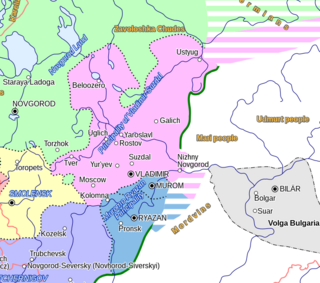
Vladimir-Suzdal, formally known as the Principality of Vladimir-Suzdal or Grand Principality of Vladimir (1157–1331), also as Suzdalia or Vladimir-Suzdalian Rus', was one of the major principalities emerging from Kievan Rus' in the late 12th century, centered in Vladimir-on-Klyazma. With time the principality grew into a grand principality divided into several smaller principalities. After being conquered by the Mongol Empire, the principality became a self-governed state headed by its own nobility. A governorship of the principality, however, was prescribed by a jarlig issued from the Golden Horde to a Rurikid sovereign.

The Khanate of Kazan was a Tatar state that occupied the territory of the former Volga Bulgaria between 1438 and 1552. The khanate covered contemporary Tatarstan, Mari El, Chuvashia, Mordovia, and parts of Udmurtia and Bashkortostan; its capital was the city of Kazan. It was one of the successor states of the Golden Horde (Mongol state), and it came to an end when it was conquered by the Tsardom of Russia.

Bolghar was intermittently the capital of Volga Bulgaria from the 10th to the 13th centuries, along with Bilyar and Nur-Suvar. It was situated on the bank of the Volga River, about 30 km downstream from its confluence with the Kama River and some 130 km from modern Kazan in what is now Spassky District. West of it lies a small modern town, since 1991 known as Bolgar. The UNESCO World Heritage Committee inscribed Bolgar Historical and Archaeological Complex to the World Heritage List in 2014.
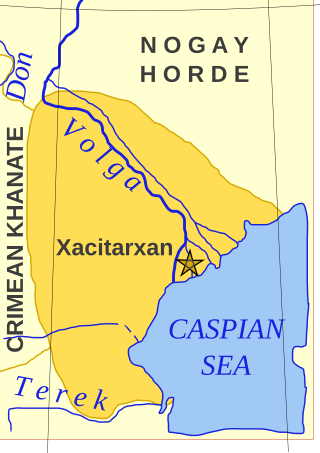
The Khanate of Astrakhan was a Tatar rump state of the Golden Horde. The khanate existed in the 15th and 16th centuries in the area adjacent to the mouth of the Volga river, around the modern city of Astrakhan. Its khans claimed patrilineal descent from Toqa Temür, the thirteenth son of Jochi and grandson of Genghis Khan.

Dzhan-Ali was ruler of the Khanate of Qasim in 1519–1532 and then Khanate of Kazan in 1532–1535. He was the son of Qasim khan Sheikh Auliyar (Şäyexäwliyär) and younger brother of Qasim khan Shah-Ali (Şahğali).

Shah-Ali was a khan of the Qasim Khanate and the Khanate of Kazan. He ruled the Qasim Khanate for much of his life and three times tried to rule the Khanate of Kazan, which was independent until its conquest by Muscovy in 1552. He also ruled the town of Kasimov as a vassal of the Russians. He was the son of the Qasim Khan Sheikh Auliyar and grandson of Bakhtiar Sultan, a brother of Ahmed Khan bin Küchük. One of his wives was the unfortunate Söyembikä of Kazan. He died childless in 1567 and was succeeded by Sain Bulat. He is described as physically repulsive and too fat to be a soldier, but a man of sound judgement. Shah-Ali was a direct descendant of Jochi Khan, the eldest son of Genghis Khan.

Kasimov is a town in Ryazan Oblast, Russia, located on the left bank of the Oka River. Population: 33,491 (2010 Census); 35,816 (2002 Census); 37,521 (1989 Soviet census); 17,000 (1910).
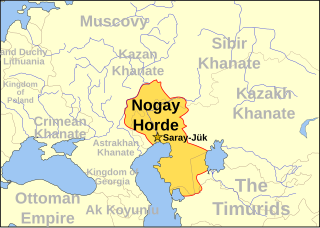
The Nogai Horde was a confederation founded by the Nogais that occupied the Pontic–Caspian steppe from about 1500 until they were pushed west by the Kalmyks and south by the Russians in the 17th century. The Mongol tribe called the Manghuds constituted a core of the Nogai Horde.
Qasím Khan was the first khan of the Tatar Qasim Khanate, from 1452 until his death in 1469. He was the son of the Kazan khan Oluğ Möxämmäd.
Mishar Yurt was a semi-autonomous principality of the Golden Horde at the border of Moscow, Nizhny Novgorod and Ryazan duchies.

The Russo-Kazan Wars were a series of short, intermittent wars fought between the Grand Principality of Moscow and the Khanate of Kazan between 1437 and 1556. Most of these were wars of succession in Kazan, in which Muscovy intervened on behalf of the dynastic interests of its main ally, the Crimean Khanate. For most of the period, neither side sought to conquer the other, until Ivan the Terrible decided to annex Kazan upon the successful 1552 siege, which was followed by a rebellion lasting until 1556.
The Battle of Suzdal or the Battle of the Kamenka River was fought on 7 July 1445, between Russians under Vasily II and Tatar troops of Oluğ Möxämmäd, who invaded the principality of Nizhny Novgorod. The Russians were defeated by troops of beg Mäxmüd, who became Mäxmüd of Kazan after the battle. Vasily was taken prisoner and was set free only after the enormous ransom was paid. He also promised restitution of the lands of Mishar Yurt, that were bought from Tokhtamysh in 1343. Qasim Khanate was founded there to become a buffer state and the vassal of Muscovy later.

Ulugh Muhammad or Muhammad Khan was a medieval Tatar statesman, Gengisid, Khan of the Golden Horde, ruler of Crimea (1437), and the founder of the Khanate of Kazan, which he ruled from 1438–1445. He was the son of the oglan Ichkile Hassan and the cousin of Tokhtamysh. He received the nickname "Ulugh", meaning older or large, in contrast to Küchük Muhammad, meaning younger or small.
The gathering of the Russian lands or Rus' lands was the process in which new states – usually the Principality of Moscow and the Grand Duchy of Lithuania – acquired former territories of Kievan Rus' from the 14th century onwards, claiming to be its legitimate successor. In Russian historiography, this phenomenon represented the consolidation of a national state centered on Moscow. The sobriquet gatherer of the Russian lands or Rus' Land is also given to the grand princes of Moscow by Russian historians, especially to Ivan III. The term is also used to describe the expansion of the Grand Duchy of Lithuania into Rus' principalities; the Lithuanian grand dukes claimed authority over all territories inhabited by Rus' people. Some historians argue that Lithuania began "gathering Rus' lands" before Muscovy did.
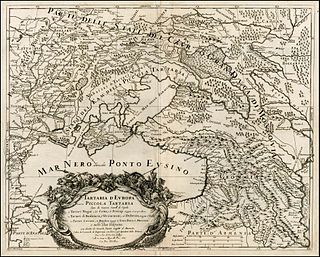
Mordvin Tatars was a term used to refer to medieval nobility of Volga Tatar, Volga Finnic, and Burtas descent serving Grand Duchy of Moscow.
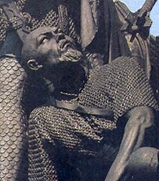
The Great Troubles, also known as the Golden Horde Dynastic War, was a war of succession in the Golden Horde from 1359 to 1381.

The siege of Kazan took place between 18 May and 9 July 1487, during a succession dispute for the Khanate of Kazan's throne. Troops from the Principality of Moscow which commanded by Daniil Kholmsky intended to capture its capital Kazan in order to restore the reign of Möxämmädämin.

















